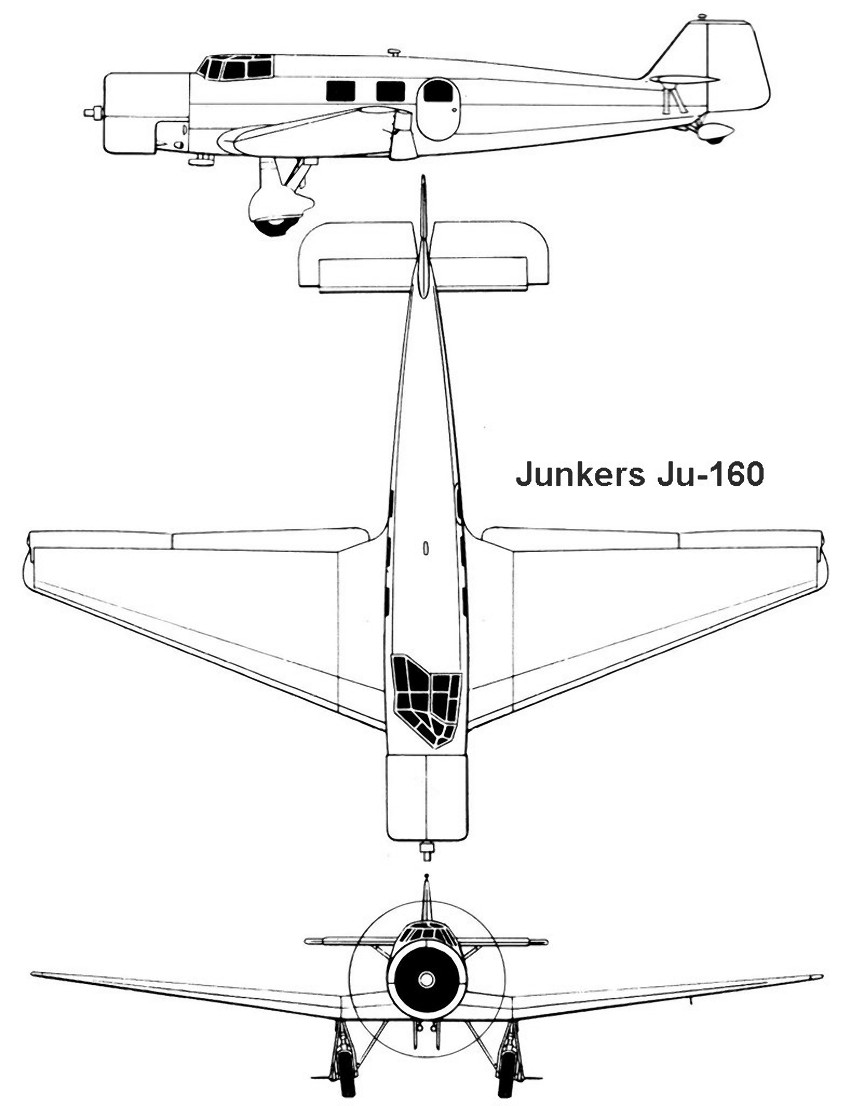Nevertheless, work on two prototypes of the Ju 60 was continued at Dessau and the first of these, the Ju 60a (c/n 4200) registered D-5, flew in September 1932 with a Pratt & Whitney Hornet A2 nine-cylinder radial rated at 525 hp at 1,900 rpm for take-off and 600 hp at 2,000 rpm at 3,280 ft (1000 m). The Hornet A2 was replaced early in the flight test programme by a Siemens Sh 20 ninecylinder radial rated at 580 hp at 1,860 rpm at 1,640 ft (500 m) and with which the prototype was redesignated Ju 60bi, this power plant giving place in turn, early in 1934, to a Pratt & Whitney Hornet T2D2 affording 670 hp for take-off and driving a two-bladed Junkers-Hamilton propeller of 9-84 ft (3,0 m) diameter in place of the three-bladed Hamilton Standard of 9-35 ft (2,85 m) diameter previously fitted. By this time, the first prototype had been fitted with retractable main undercarriage members and was designated Ju-60dli.
The main undercarriage members retracted forward into bulged wing fairings, the wheels remaining semi-exposed, and this feature had been introduced by the second prototype, the Ju 606a1 (c/n 4201) registered D-2400. Powered by a BMW Hornet, this aircraft was delivered to DLH shortly after completion and, named Pfeil (Arrow), flew route proving trials as a freighter over the Berlin-Vienna-Budapest-Sofia-Salonika-Athens route until the summer of 1933. It was subsequently converted to accommodate six passengers as the Ju 60cle and operated by DLH over the Berlin-Breslau-Gleiwitz and the Essen-Diisseldorf-Cologne-Frankfurt-Nuremberg-Munich routes, eventually being re-registered D-UPAL. After withdrawal from DLH service early in 1936, the Ju 60cle was transferred to the Luftwaffe and subsequently served as a liaison aircraft at the Rechlin test centre. The first prototype was also to be used briefly by DLH as a short-range liaison aircraft with the registration D-URIM.
Powered by a BMW Hornet C rated at 550 hp, the Ju 60ba1 possessed essentially similar performance to that of the Ju 60a and empty weight, too, was similar, although normal loaded weight was reduced to 6,834 lb (3100 kg). Flown for the first time in June 1934, the Ju 160 V 1 (c/n 4202) D-UNOR Luchs (Lynx) was powered by a 650 hp Pratt & Whitney Hornet T2D1 radial. The equi-tapered wing with corrugated skinning featured by the Ju 60 gave place to a wing which, while'retaining the same span and area as that of the earlier design, featured substantially increased leading-edge taper and slight negative trailing-edge taper, utilised a new aerofoil section and had smooth skinning. The tail surfaces were similar to those of the Ju 60 but had smooth skinning; the main undercarriage members retracted inwards into centre-section wells and the two crew members occupied side-by-side staggered positions whereas those of the Ju 60 had mounted in tandem. The main cabin provided accommodation for six passengers.
The production model, the Ju 160A, was powered by the BMW 132E (licence-built Pratt & Whitney Hornet) rated at 730 hp at 2,050 rpm for take-off and 660 hp at 2,000 rpm at 3,280 ft (1000 m), and differed from the prototype primarily in having a marginally longer fuselage and a broader-chord rudder of reduced depth. Production of the Ju 160 was to total 48 aircraft of which 20 were to be delivered to DLH, 11 of these serving on the so-called Blitzstrecken by the summer of 1935, and at least 16 remaining in the DLH inventory at the beginning of W W II. Apart from two examples (of the Ju 160D-0) exported to Japan and at least three to the DVL (Deutsche Versuchsanstalt fiir Luftfahrt-German Aviation Experimental Establishment), the remaining aircraft were delivered to the Luftwaffe for the liaison role. In addition to the basic Ju 160 production model, variants included the Ju 160A-2 intended for the military liaison role with a four-seat main cabin of which two-three were delivered to the Luftwaffe; the Ju 160B-0 which, powered by the BMW 132A, was a special version for the DVL which took delivery of two; the Ju 160C-0 with a BMW 132A and increased take-off weight of which eight were supplied to DLH, one later being transferred to the DVL; the Ju 160C-2 military version of the C-0 for the Luftwaffe of which 14 were built (two of these being assigned to DLH for use as freighters) and the Ju 160D-0 which reverted to the BMW 132E engine and had the increased take-off weight of the C-0.
| Type |
|
| Engine |
|
| Dimensions |
Length , height , span , wing area , |
| Weights |
Empty , loaded , max. take off weight |
| Performance |
Max.. speed , cruising speed , range , endurance , service ceiling , climb |
| Armament |
|

